key TOYOTA HIGHLANDER 2012 XU40 / 2.G Owners Manual
[x] Cancel search | Manufacturer: TOYOTA, Model Year: 2012, Model line: HIGHLANDER, Model: TOYOTA HIGHLANDER 2012 XU40 / 2.GPages: 636, PDF Size: 11.24 MB
Page 504 of 636

504 4-3. Do-it-yourself maintenance
23 EPS80 A Electric power steering
24 ST 30 A Starting system
25 CRT 10 ARear seat entertainment system,
audio system
26 RADIO NO.1 20 A Audio system
27 ECU-B NO.1 10 A Steering sensor, gauges and
meters, clock, main body ECU,
wireless remote control, smart key
system, power back door, multi-
information display, front passen-
ger occupant classification system
28 DOME 10 AVanity lights, personal lights, inte-
rior light, gauges and meters,
engine switch light, door courtesy
lights
29 TOWING 30 A Trailer lights
30 STR LOCK 20 A Steering lock system
31 EFI MAIN 25 AMultiport fuel injection system/
sequential multiport fuel injection
system, EFI NO.2, EFI NO.3
32 HAZ 15 A Turn signal lights
33 IG2 25 AINJ NO.1, INJ NO.2, IGN, GAUGE
NO.2
34 AMP 15 A Audio system
35 RR FOG 7.5 A No circuit
36 DEICER 15 A Windshield wiper de-icer
37 G/H 10 AGlass hatch, multiplex communica-
tion system, outer foot lights
38 ALT-S 7.5 A Charging system
39 AM2 7.5 A Multiplex communication system
40 H-LP LH HI 15 A Left-hand headlight (high beam)
FuseAmpereCircuit
Page 505 of 636
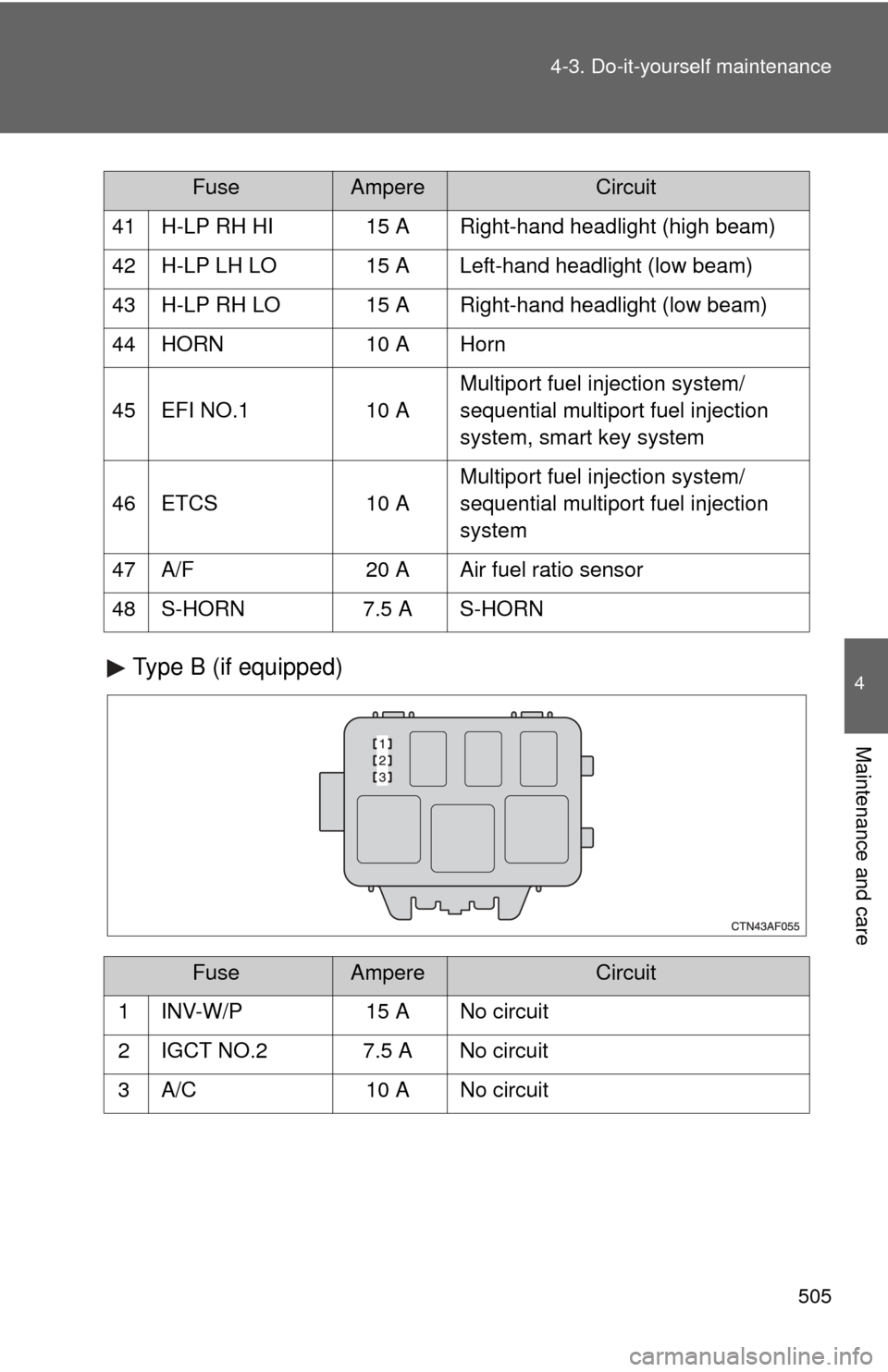
505
4-3. Do-it-yourself maintenance
4
Maintenance and care
Type B (if equipped)
41 H-LP RH HI 15 A Right-hand headlight (high beam)
42 H-LP LH LO 15 A Left-hand headlight (low beam)
43 H-LP RH LO 15 A Right-hand headlight (low beam)
44 HORN 10 A Horn
45 EFI NO.1 10 A
Multiport fuel injection system/
sequential multiport fuel injection
system, smart key system
46 ETCS 10 A Multiport fuel injection system/
sequential multiport fuel injection
system
47 A/F 20 A Air fuel ratio sensor
48 S-HORN 7.5 A S-HORN
FuseAmpereCircuit
1 INV-W/P 15 A No circuit
2 IGCT NO.2 7.5 A No circuit
3 A/C 10 A No circuit
FuseAmpereCircuit
Page 508 of 636

508 4-3. Do-it-yourself maintenance
22 GAUGE NO.1 10 AAudio system, back-up lights,
charging system, emergency flash-
ers, traction control system, wind-
shield wiper de-icer, air
conditioning system, charging sys-
tem, rear view monitor system,
trailer lights, multiport fuel injection
system/sequential multiport fuel
injection system
23 FR WIP 30 A Windshield wipers and washer
24 RR WIP 15 A Rear window wiper and washer
25 IGN 10 A Multiport fuel injection system/
sequential multiport fuel injection
system, steering lock system,
smart key system, SRS airbag sys-
tem
26 GAUGE NO.2 7.5 A Gauges and meters, rear view
monitor system
27 ECU-ACC 7.5 A Outside rear view mirrors, shift lock
system, smart key system, multi-
plex communication system
28 ACC SOCK
NO.1 15 A Power outlet
29 ACC SOCK
NO.2 15 A Power outlet
30 RADIO NO.2 7.5 A Audio system, clock, rear seat
entertainment system, interior
lights, personal lights
FuseAmpereCircuit
Page 517 of 636
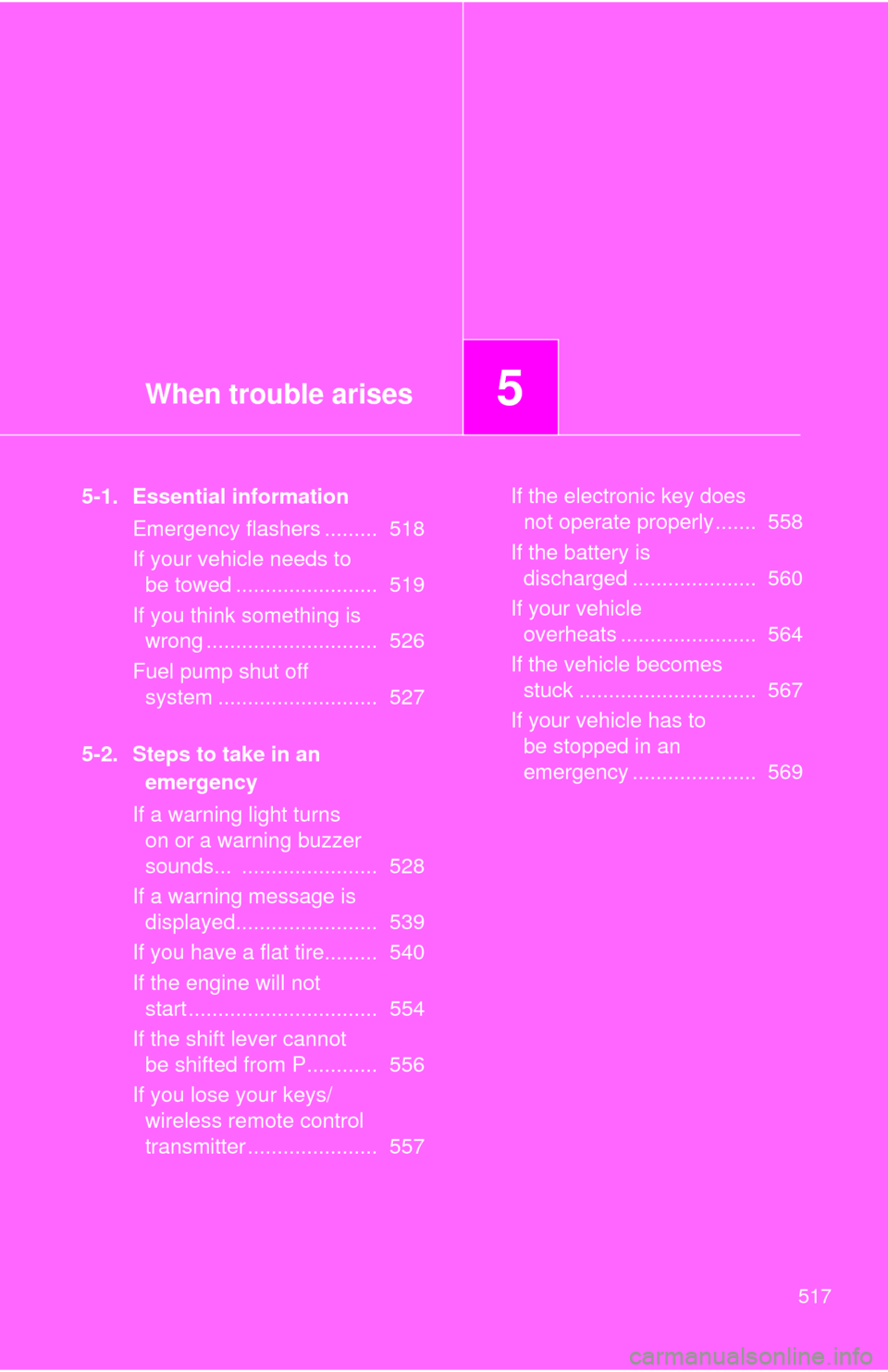
When trouble arises5
517
5-1. Essential informationEmergency flashers ......... 518
If your vehicle needs to be towed ........................ 519
If you think something is wrong ............................. 526
Fuel pump shut off system ........................... 527
5-2. Steps to take in an emergency
If a warning light turns on or a warning buzzer
sounds... ....................... 528
If a warning message is displayed........................ 539
If you have a flat tire......... 540
If the engine will not start ................................ 554
If the shift lever cannot be shifted from P............ 556
If you lose your keys/ wireless remote control
transmitter ...................... 557 If the electronic key does
not operate properly....... 558
If the battery is discharged ..................... 560
If your vehicle overheats ....................... 564
If the vehicle becomes stuck .............................. 567
If your vehicle has to be stopped in an
emergency ..................... 569
Page 520 of 636
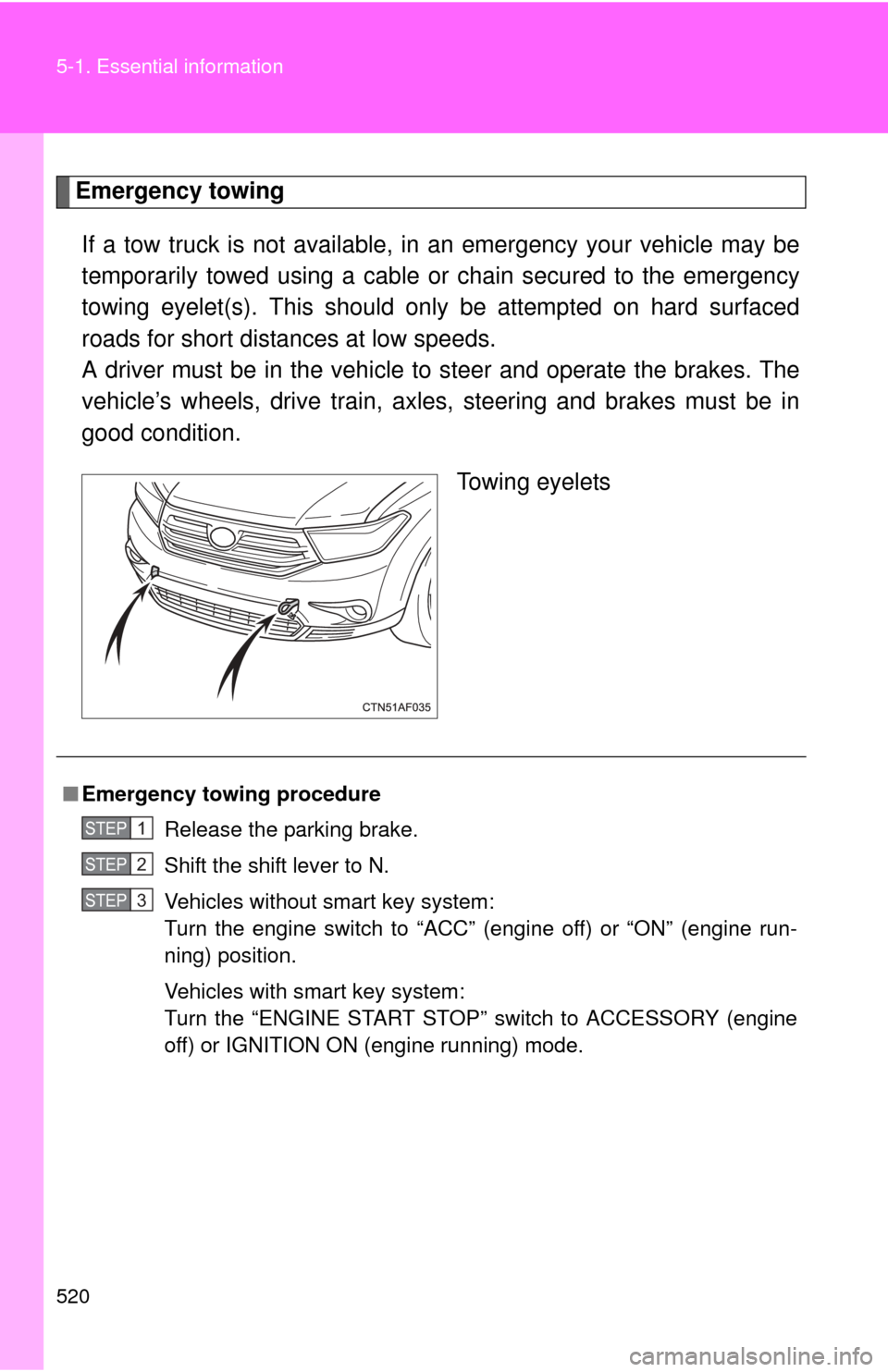
520 5-1. Essential information
Emergency towingIf a tow truck is not available, in an emergency your vehicle may be
temporarily towed using a cable or chain secured to the emergency
towing eyelet(s). This should only be attempted on hard surfaced
roads for short distances at low speeds.
A driver must be in the vehicle to steer and operate the brakes. The
vehicle’s wheels, drive train, axles, steering and brakes must be in
good condition.
Towing eyelets
■Emergency towin g procedure
Release the parking brake.
Shift the shift lever to N.
Vehicles without smart key system:
Turn the engine switch to “ACC” (engine off) or “ON” (engine run-
ning) position.
Vehicles with smart key system:
Turn the “ENGINE START STOP” switch to ACCESSORY (engine
off) or IGNITION ON (engine running) mode.
STEP1
STEP2
STEP3
Page 527 of 636
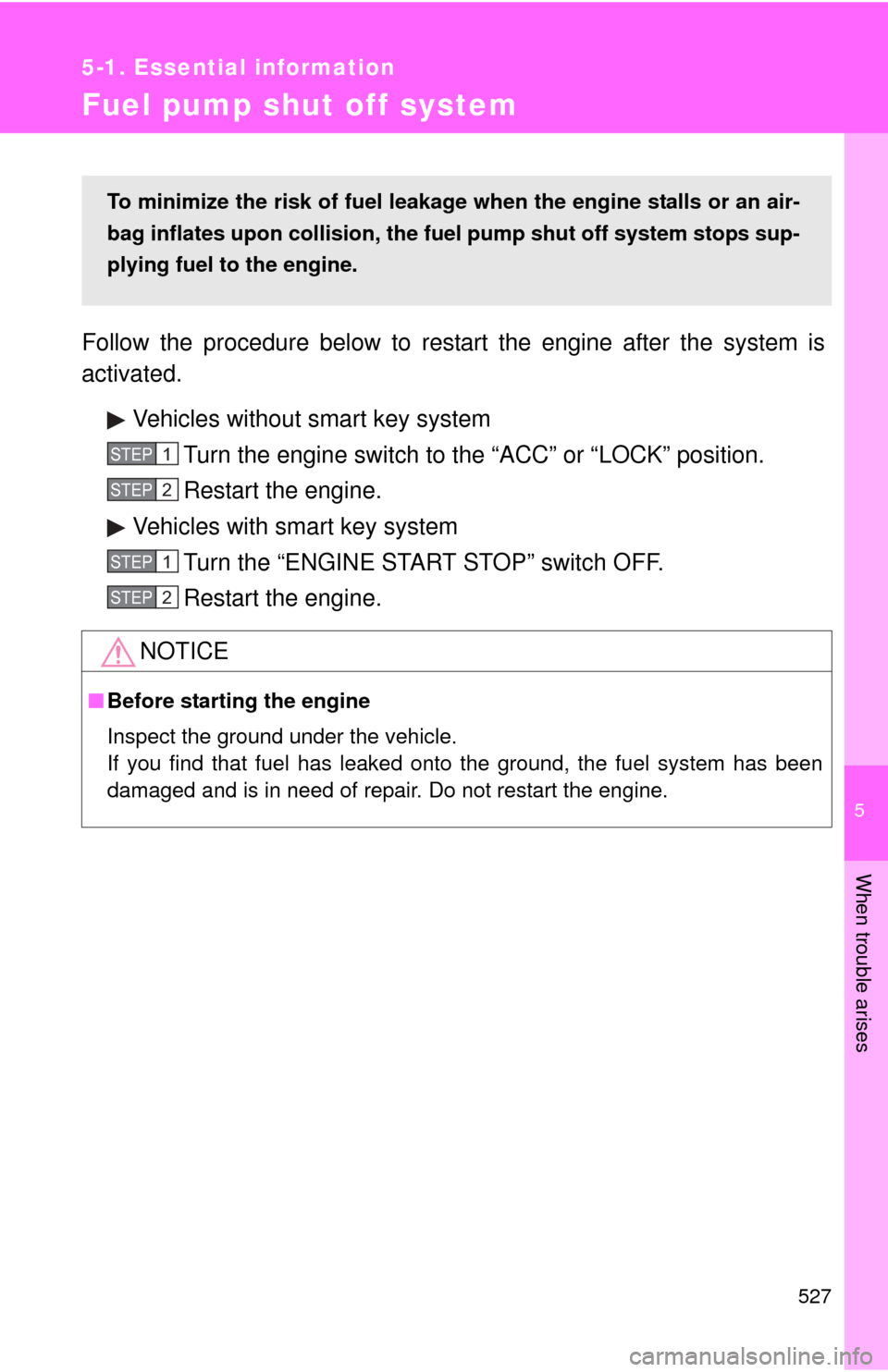
5
When trouble arises
527
5-1. Essential information
Fuel pump shut off system
Follow the procedure below to restart the engine after the system is
activated.Vehicles without smart key systemTurn the engine switch to the “ACC” or “LOCK” position.
Restart the engine.
Vehicles with smart key system Turn the “ENGINE START STOP” switch OFF.
Restart the engine.
NOTICE
■Before starting the engine
Inspect the ground under the vehicle.
If you find that fuel has leaked onto the ground, the fuel system has been
damaged and is in need of repair. Do not restart the engine.
To minimize the risk of fuel leakage when the engine stalls or an air-
bag inflates upon collision, the fu el pump shut off system stops sup-
plying fuel to the engine.
STEP1
STEP2
STEP1
STEP2
Page 534 of 636

534 5-2. Steps to take in an emergency
*1: Open door warning buzzer:The open door warning buzzer sounds to alert one or more of the doors is
not fully closed (with the vehicle having reached a speed of 3 mph [5 km/h]).
*2: Driver's and front passenger’s seat belt reminders:
The driver’s and front passenger’s seat belt reminders sound to alert the
driver and front passenger that his or her seat belt is not fastened. These
buzzers sound for 10 seconds after the vehicle has reached a speed of at
least 12 mph (20 km/h). Then, if the seat belt is still unfastened, the buzzer
will sound in a different tone for 20 more seconds.
*3: Vehicles without navigation system
*4: Vehicles with navigation system
*5: Refer to the separate “Scheduled Maintenance Guide” or “Owner’s ManualSupplement” for the maintenance interval applicable to your vehicle.
■ Key reminder buzzer (vehic les without smart key system)
The buzzer indicates that the key has not been removed with the engine off
and the driver’s door opened.
■ Open moon roof reminder buzzer (vehicles with mult i-information dis-
play)
The buzzer indicates that the moon roof is not fully closed with the engine off
and the driver’s door opened.
■ Front passenger detect ion sensor and passenger seat belt reminder
● If luggage is placed on the front passenger seat, the front passenger
detection sensor may cause the warning light to flash, even if a passen-
ger is not sitting in the seat.
● If a cushion is placed on the seat, the sensor may not detect a passen-
ger, and the warning light may not operate properly.
■ Engine oil replacement re minder light (U.S.A. vehicles without multi-
information display)
The engine oil replacement reminder light will come on and flash at approxi-
mately 4500 miles (7200 km) after an oil change. When the distance driven
after an oil change exceeds approximately 5000 miles (8000 km), the light
will come on and remain on.
Page 536 of 636

536 5-2. Steps to take in an emergency
The tire pressure warning system may be disabled in the following condi-
tions:
(When the condition becomes normal, the system will work properly.)
●If electronic devices or facilities using similar radio wave frequencies
are nearby.
●If a radio set at similar frequencies is in use in the vehicle.
●If a window tint that affects the radio wave signals is installed.
●If there is a lot of snow or ice on the vehicle, in particular around the
wheels or wheel housings.
●If non-genuine Toyota wheels are used. (Even if you use Toyota
wheels, the tire pressu re warning system may not work properly with
some types of tires.)
●If tire chains are used.
●If the spare tire is in a location subject to poor radio wave signal
reception.
●If a large metallic object which can interfere with signal reception is
put in the luggage room.
■If the tire pressure warning light frequently comes on after blinking
for 1 minute
Vehicles without smart key system
If the tire pressure warning light comes on after blinking for 1 minute fre-
quently when the engine switch is turned to the “ON” position, have it
checked by your Toyota dealer. Vehicles with smart key system
If the tire pressure warning light comes on after blinking for 1 minute fre-
quently when the “ENGINE START STOP” switch is turned to IGNITION
ON mode, have it checked by your Toyota dealer.
Page 542 of 636
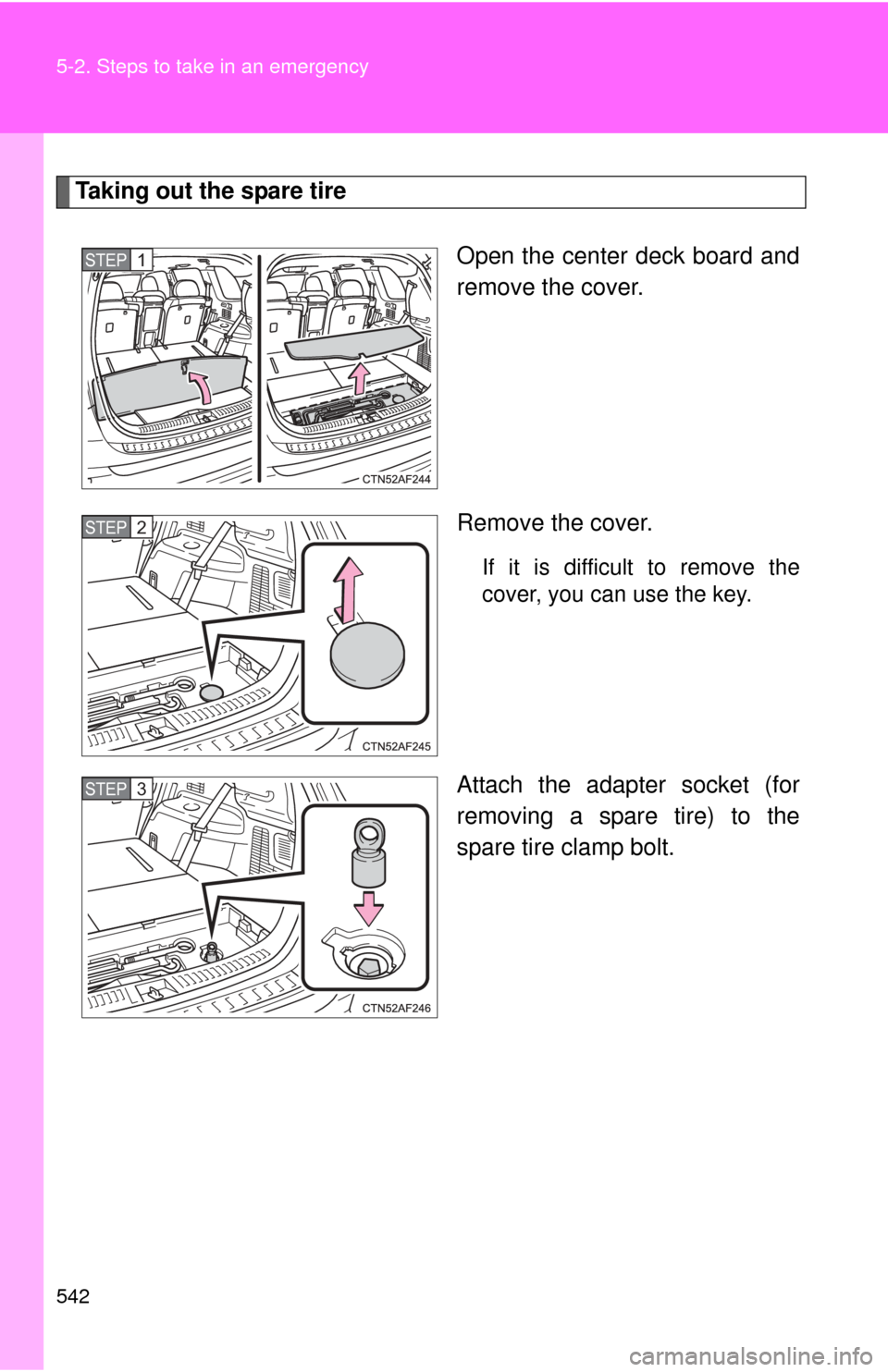
542 5-2. Steps to take in an emergency
Taking out the spare tireOpen the center deck board and
remove the cover.
Remove the cover.
If it is difficult to remove the
cover, you can use the key.
Attach the adapter socket (for
removing a spare tire) to the
spare tire clamp bolt.
STEP1
STEP2
STEP3
Page 554 of 636

554
5-2. Steps to take in an emergency
If the engine will not star t
If the engine still does not start after following the correct starting
procedure (P. 170, 174) or releasing the steering lock ( P. 172,
175), confirm the fo llowing points.
■The engine will not start even when the starter motor oper-
ates normally.
One of the following may be the cause of the problem.
●There may not be sufficient fuel in the vehicle’s tank.
Refuel the vehicle.
● The engine may be flooded.
Try to restart the engine once more following correct starting
procedures. ( P. 170, 174)
● There may be a malfunction in the engine immobilizer system
(if equipped). ( P. 11 3 )
■ The starter motor turns over slowly, the interior lights and
headlights are dim, or the horn does not sound or sounds at
a low volume.
One of the following may be the cause of the problem.
●The battery may be discharged. ( P. 560)
● The battery terminal connec tions may be loose or corroded.
■ The starter motor does not turn over (vehicles with smart
key system).
The engine starting system may be malfunctioning due to an
electrical problem such as an open circuit or a blown fuse. How-
ever, an interim measure is available to start the engine.
( P. 555)